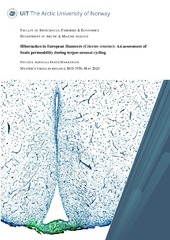| dc.contributor.advisor | Wood, Shona | |
| dc.contributor.advisor | Simonneaux, Valérie | |
| dc.contributor.advisor | Hazlerigg, David | |
| dc.contributor.author | Markussen, Fredrik Andreas Fasth | |
| dc.date.accessioned | 2021-05-25T13:40:35Z | |
| dc.date.available | 2021-05-25T13:40:35Z | |
| dc.date.issued | 2020-05-22 | |
| dc.description.abstract | Hibernation is a physiological and behavioural adaptation that permits survival during seasonal periods of energy shortage via a combination of pre-hibernal energy storage and hibernal metabolic depression, i.e. torpor. The central mechanisms in the brain that control torpor expression and arousal from it has been under investigation since the dawn of hibernation research but remains unknown. Recent reports on the role of tanycytes, a specialised glial cell within the brain’s circumventricular organs, in energy homeostasis and metabolic sensing provides a promising avenue for investigation regarding their role in hibernation. One interesting aspect is that tanycytes have been shown to alter brain barrier function depending on organismic energetic state. Therefore, this study aimed to assess brain permeability during torpid and awake states in a true hibernator, the European hamster (<i>Cricetus cricetus</i>), by perfusion of the brain with a small biotinylated tracer molecule. Additionally, a minimally invasive method for hibernation monitoring and detecting arousal events has been validated. We show that small subcutaneous temperature transponders positioned in interscapular brown adipose tissue combined with intraperitoneal temperature loggers allows superior detection of the earliest events of arousal. These data reveal the dynamics of the re-warming (arousal) process, showing brown adipose tissue rewarming precedes core body temperature by up to an hour. We also note that rewarming capacity from torpor is impaired in animals bearing thymus tumours in the thoracic cavity. We found that the blood-brain barrier remains intact both at the level of capillaries and in circumventricular organs during hibernation. This suggests that accessibility of peripheral metabolites to the brain by passive diffusion is not altered during torpor, and may indicate that alterations in intrinsic properties of regulatory neuronal populations regulate torpor arousal cycling. Tanycyte morphology was also unaltered during torpor arousal cycling indicating that further research should focus on the intrinsic properties of these cells rather than the morphology. Taken together, this study provides detailed insight into arousal patterns, brain permeability and tanycyte morphology of the European hamster. | en_US |
| dc.identifier.uri | https://hdl.handle.net/10037/21241 | |
| dc.language.iso | eng | en_US |
| dc.publisher | UiT Norges arktiske universitet | en_US |
| dc.publisher | UiT The Arctic University of Norway | en_US |
| dc.rights.accessRights | openAccess | en_US |
| dc.rights.holder | Copyright 2020 The Author(s) | |
| dc.rights.uri | https://creativecommons.org/licenses/by-nc-sa/4.0 | en_US |
| dc.rights | Attribution-NonCommercial-ShareAlike 4.0 International (CC BY-NC-SA 4.0) | en_US |
| dc.subject.courseID | BIO-3950 | |
| dc.subject | VDP::Matematikk og Naturvitenskap: 400::Zoologiske og botaniske fag: 480::Zoofysiologi og komparativ fysiologi: 483 | en_US |
| dc.subject | VDP::Mathematics and natural science: 400::Zoology and botany: 480::Zoophysiology and comparative physiology: 483 | en_US |
| dc.title | Hibernation in European Hamsters (Cricetus crisetus): An assessment of brain permeability during torpor-arousal cycling | en_US |
| dc.type | Master thesis | en_US |
| dc.type | Mastergradsoppgave | en_US |


 English
English norsk
norsk
